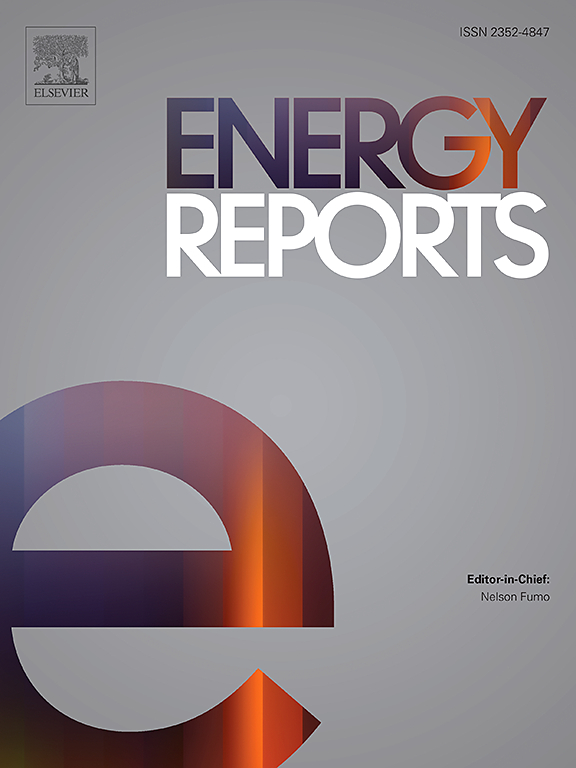Thermo-catalytic pyrolysis and kinetic study of non-edible castor seeds into renewable liquid fuel and value-added chemicals
IF 5.1
3区 工程技术
Q2 ENERGY & FUELS
引用次数: 0
Abstract
Biomass is a promising renewable resource due to its availability, low processing cost, high conversion efficiency, and reduced life-cycle carbon emissions, making it a potential alternative to fossil fuels. However, the pyrolysis-derived pyrolytic oil typically suffers from poor quality, high viscosity, thermal instability, and corrosiveness, limiting its direct use as fuel. These drawbacks can be mitigated through catalytic upgrading. Thus, the present study investigates the kinetic behaviour and thermo-catalytic pyrolysis of castor seeds using a semi-batch reactor at 550 °C, 50 °C min−1 heating rates and 100 mL min−1 nitrogen flow rate. Thermogravimetric analysis was conducted at heating rates of 10, 30, and 50 °C min−1, applying Ozawa-Flynn-Wall, Friedman (FM), Kissinger-Akahira-Sunose (KAS), Vyazovkin (VZ), Starink (STM), alongside the Criado model. The average apparent activation energies were determined as 174.69, 172.25, 173.53, 66.17, and 156.93 kJ mol−1 for OFW, KAS, STM, VZ, and FM, respectively. The Criado model confirmed that biomass decomposition follows a complex, multi-step reaction mechanism. Further, pyrolysis using ZSM-5 and ZnO catalysts enhanced pyrolytic oil yields from 49.82 wt% (thermal) to 55.52 wt% and 54.33 wt%, respectively. Catalyst inclusion also improved the carbon content (by 14.12 % for ZSM-5 and 12.19 % for ZnO), higher heating value (by 1.72 and 1.00 MJ kg−1), and pH (by 0.89 and 1.50). The resulting biochar exhibited 57.14 % carbon content, 36.23 % oxygen, 19.88 MJ kg−1 Higher heating value, and a Brunauer-Emmett-Teller surface area of 84.98 m² g−1. Overall, this study highlights the potential of castor seeds as a viable feedstock for sustainable fuel production through catalytic biomass valorisation.
非食用蓖麻籽热催化热解制备可再生液体燃料及增值化学品的动力学研究
生物质可获得性好、加工成本低、转化效率高、生命周期碳排放少,是一种很有前途的可再生资源,是化石燃料的潜在替代品。然而,热解衍生的热解油通常存在质量差、粘度高、热不稳定性和腐蚀性等问题,限制了其作为燃料的直接使用。这些缺点可以通过催化升级加以缓解。因此,本研究使用半间歇反应器在550 °C, 50 °C min - 1加热速率和100 mL min - 1氮气流量下研究蓖麻种子的动力学行为和热催化热解。采用Ozawa-Flynn-Wall、Friedman (FM)、Kissinger-Akahira-Sunose (KAS)、Vyazovkin (VZ)、Starink (STM)和Criado模型,在升温速率为10、30和50 °C min−1的情况下进行热重分析。OFW、KAS、STM、VZ和FM的平均表观活化能分别为174.69、172.25、173.53、66.17和156.93 kJ mol−1。Criado模型证实,生物质分解遵循一个复杂的、多步骤的反应机制。此外,使用ZSM-5和ZnO催化剂热解,热解油收率分别从49.82 wt%(热)提高到55.52 wt%和54.33 wt%。ZSM-5和ZnO的含碳量分别提高了14.12 %和12.19 %,热值分别提高了1.72和1.00 MJ kg−1,pH分别提高了0.89和1.50。所得生物炭碳含量为57.14 %,氧含量为36.23 %,热值为19.88 MJ kg−1,brunauer - emmet - teller比表面积为84.98 m²g−1。总的来说,这项研究强调了蓖麻籽作为一种可行的原料的潜力,通过催化生物质增值可持续燃料生产。
本文章由计算机程序翻译,如有差异,请以英文原文为准。
求助全文
约1分钟内获得全文
求助全文
来源期刊

Energy Reports
Energy-General Energy
CiteScore
8.20
自引率
13.50%
发文量
2608
审稿时长
38 days
期刊介绍:
Energy Reports is a new online multidisciplinary open access journal which focuses on publishing new research in the area of Energy with a rapid review and publication time. Energy Reports will be open to direct submissions and also to submissions from other Elsevier Energy journals, whose Editors have determined that Energy Reports would be a better fit.
 求助内容:
求助内容: 应助结果提醒方式:
应助结果提醒方式:


